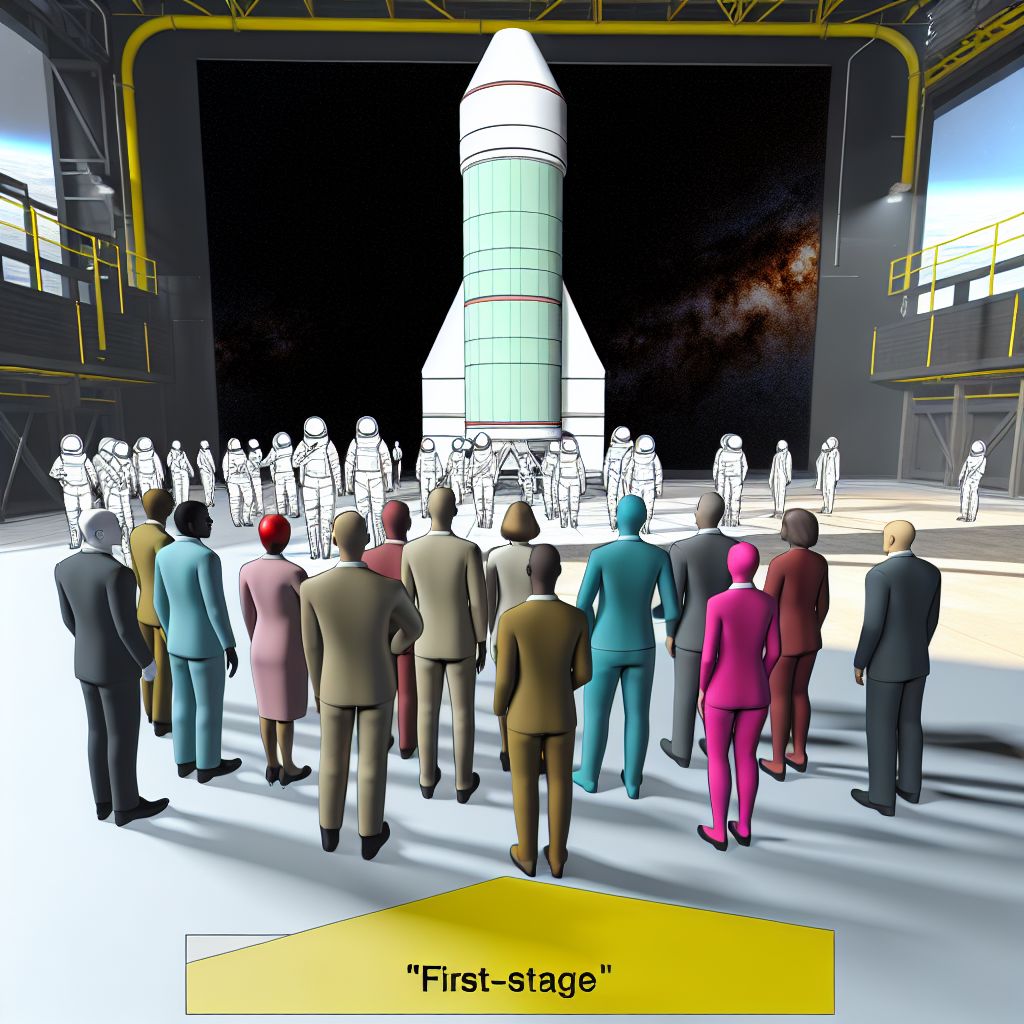Deutsch: Erste Stufe / Español: Primera etapa / Português: Primeira etapa / Français: Premier étage / Italiano: Primo stadio
First-stage in the Space industry context refers to the initial part of a rocket's launch system, which is primarily responsible for providing the initial Thrust to Lift the rocket from the Ground and commence its journey into space. The first stage is a Critical Component of a rocket's overall architecture, featuring its own engines and fuel supply which are designed to overcome the gravitational pull of the Earth.
Description

The first stage of a rocket typically contains the largest engines and the majority of the fuel used during a launch. This stage must generate enough thrust to significantly propel the rocket upwards, carrying it through the thickest part of the Earth's Atmosphere. Once its fuel is expended, the first stage is usually detached from the rest of the rocket to reduce Weight and allow the second stage to continue the journey with less Mass to carry. This process is known as staging.
Application Areas
First-stage technology is crucial in multiple areas within Aerospace Engineering and operations:
- Launch Vehicles: Every orbital and suborbital mission begins with a first-stage launch, whether it involves launching satellites, space probes, or crewed Spacecraft.
- Military Ballistics: Many intercontinental Ballistic missiles (ICBMs) use a similar staged approach to reach their targets, with a first stage that lifts the missile from its silo or launch platform.
- Space Tourism: Emerging commercial spaceflight ventures also rely on first-stage technology to launch their vehicles beyond Earth's atmosphere.
Well-Known Examples
- Falcon 9’s First Stage: SpaceX’s Falcon 9 rocket is notable for its reusable first stage, which returns to a landing site or Drone ship at sea after separating from the second stage. This innovation significantly reduces the cost of Access to space.
- Saturn V First Stage: During the Apollo missions, the Saturn V rocket used its massive first stage, known as the S-IC, to achieve initial lift-off and break free of Earth’s gravitational pull.
- Space Launch System (SLS) Booster: NASA’s next-generation Heavy-lift vehicle also uses a powerful first stage to start its journey toward deep space missions.
Treatment and Risks
Managing a successful first-stage operation involves several critical considerations:
- Reliability of Engines: The engines must be highly reliable as their failure could lead to mission failure.
- Aerodynamic Stability: The first stage must be aerodynamically stable as it passes through the atmosphere at high speeds.
- Structural Integrity: The structure needs to withstand immense forces during lift-off and Flight through the atmosphere.
- Safety and Recovery Systems: Especially for reusable first stages, safe recovery mechanisms such as parachutes, landing legs, and control systems for guided descents are crucial.
Similar Terms
- Booster: Often used interchangeably with the first stage, although boosters can sometimes refer to additional rockets that assist the main first stage.
- Launch Vehicle: The entire rocket system that includes the first stage, any additional stages, and the Payload.
Summary
In the space industry, the first-stage of a rocket is the foundation of any launch sequence, designed to provide the initial thrust required to begin the spacecraft’s Ascent. It is characterized by its large engines and fuel tanks designed to carry the vehicle away from Earth’s gravitational influence. Innovations in first-stage technology, such as reusability and advanced materials, continue to improve the efficiency and cost-effectiveness of space launches, making space more accessible for various missions and applications.
--
Related Articles to the term 'First-stage' | |
| 'Two-stage' | ■■■■■■■■■ |
| Two-stage in the space industry refers to a rocket Design that uses two separate propulsion stages to . . . Read More | |
| 'Fueling' | ■■■■■■ |
| Fueling in the space industry context refers to the process of loading Propellant into rockets, spacecraft, . . . Read More | |
| 'Launch Vehicle' | ■■■■■■ |
| Launch Vehicle in the space industry refers to a rocket or spacecraft specifically designed to propel . . . Read More | |
| 'Rocket Propulsion' | ■■■■■ |
| Rocket Propulsion in the space industry context refers to the method by which rockets and spacecraft . . . Read More | |
| 'Fuel-efficient' | ■■■■■ |
| Fuel-efficient in the space industry context refers to the design and operation of spacecraft, rockets, . . . Read More | |
| 'Air-launch' | ■■■■■ |
| In the space industry context, "Air-launch" refers to a method of launching spacecraft where the launch . . . Read More | |
| 'Leftover' | ■■■■■ |
| Leftover: Deutsch: / Español: Residuos / Português: Restos / Français: Restes / Italiano: RimanenzeIn . . . Read More | |
| 'Airspeed' | ■■■■■ |
| Airspeed in the space industry context generally refers to the speed of a spacecraft or launch vehicle . . . Read More | |
| 'Fixture' | ■■■■ |
| Fixture in the space industry context refers to specialized devices, structures, or assemblies used to . . . Read More | |
| 'Vibration Isolation' | ■■■■ |
| Vibration Isolation in the space industry refers to the techniques and technologies used to reduce or . . . Read More | |
